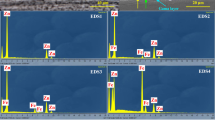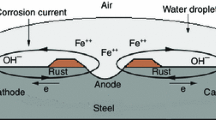Abstract
The effect of various concentrations of povidone–iodine (PI) on the corrosion behavior of a commercially pure titanium alloy (Ti-1) has been investigated in normal saline solution to simulate the povidone–iodine addition in an oral environment. The open circuit potential, electrochemical impedance spectroscopy and potentiodynamic polarization measurements have been used to characterize the electrochemical phenomena occurring on the alloy surface. The open circuit potential values for Ti-1 in various concentrations of PI shift considerably towards noble direction as compared to pure normal saline. In the potentiodynamic polarization curve for Ti-1 in various solutions, the cathodic current density has increased for all concentrations of PI and the anodic current density has decreased. Only the 0.1% PI concentration is able to inhibit corrosion of Ti-1 in normal saline and the other higher concentrations studied, accelerate corrosion. The EIS data for Ti-1 in normal saline and in various concentrations of PI follows a one time constant circuit, suggesting the formation of a single passive film on Ti-1 which is not altered by the addition of PI to normal saline.







Similar content being viewed by others
References
Demir A, Malkoc S, Sengun A, Koyuturk AE, Sener Y. Effects of chlorohexidine and povidone-iodine mouth rinses on the bond strength of an orthodontic composite. Angle Orthod. 2005;75(3):392–6.
Barabas ES. Vinylamines. Encyclopedia of polymer science and engineering, vol. 17, 2nd ed. New York: Wiley; 1989. p. 219.
Brittain HG. Analytical profiles of drug substances and excipients, vol. 25. New York: Academic Press; 1998. p. 433.
Fuoss RM, Strauss VP. Viscosity of mixtures of polyelectrolytes and simple electrolytes. Ann NY Acad Sci. 1949;51:836.
LaRocca R, LaRocca M-AK, Ansell JM. Microbiology of povidone-iodine. In: Digenis GA, Ansell J, editors. Proceedings of the international symposium on povidone. Kentucky: University of Kentucky College of Pharmacy; 1983. p. 101.
Broussoulaux C. A New Antiseptic: polyvinylpyrrolidone-iodine. Dissertation, Doctorate of Medicine, University of Paris (France), 1965 (submitted).
Cournoyer RF, Siggia S. Interaction of poly(vinyl-pyrrolidone) and iodine. J Polym Sci. 1974;12:603–12.
Daniels WE, Chiddix ME, Glickman SA. Lactam complexes of Br-HBr. J Org Chem. 1963;28:573.
Ferguson AW, Scott JA, McGavigan J, Elton RA, McLean J, Schmidt U, et al. Comparison of 5% povidone-iodine solution against 1% povidone-iodine solution in preoperative cataract surgery antisepsis: a prospective randomized double blind study. Br J Ophthalmol. 2003;87:163–7.
Rahn R. Review presentation on PI antisepsis in oral cavity. Postgrad Med J. 1993;69(3):S84–92.
Valderrama LS. Clinical application of povidone iodine oral antiseptic 1% (Betadine mouthwash) & povidone iodine skin antiseptic 10% for the management of odontogenic and deep fascial space infections. Dermatology. 2006;212(1):112–4.
Balaji SM. Sterilization and infection control. Text book of oral and maxillofacial surgery. Amsterdam: Elsevier; 2007. p. 80–96.
Balaji SM. Spread of odontogenic infections. Text book of oral and maxillofacial surgery. Amsterdam: Elsevier; 2007. p. 116–47.
Balaji SM. Therapeutics in oral surgery. Text book of oral and maxillofacial surgery. Amsterdam: Elsevier; 2007. p. 147–63.
ASTM Standard F2129-06, ASTM International, USA.
Bhola R, Bhola SM, Mishra B, Olson DL. Electrochemical behavior of titanium and its alloys as dental implants in normal saline. Res Lett Phys Chem 2009;2009:Article ID 574359.
Hsu CH, Mansfeld F. Technical note: concerning the conversion of the constant phase element parameter (Y0) into a capacitance. Corrosion. 2001;57:747–8.
Chongdar S, Gunasekaran G, Kumar P. Corrosion inhibition of mild steel by aerobic biofilm. Electrochim Acta. 2005;50:4655–65.
Cano E, Bastidas DM, Argyropoulos V, Fajardo S, Siaton A, Bastidas JM, Degrigny C. Electrochemical characterization of organic coatings for protection of historic steel artefacts. J Solid State Electrochem. 2009. doi:10.1007/S10008-009-0907-1.
Pan J, Thierry D, Leygraf C. Electrochemical impedance spectroscopy study of the passive oxide film on titanium for implant application. Electrochim Acta. 1996;41(7–8):1143–53.
Lavos-Valereto IC, Wolynec S, Ramires I, Guastaldi AC, Costa I. Electrochemical impedance spectroscopy characterization of passive film formed on implant Ti-6Al-7Nb alloy in Hank’s solution. J Mater Sci Mater Med. 2004;15(1):55–9.
Oliveira NTC, Guastaldi AC. Electrochemical stability and corrosion resistance of Ti–Mo alloys for biomedical applications. Acta Biomater. 2009;5(1):399–405.
Huynh N, Bottle SE, Notoya T, Trueman T, Hinton B, Schweinsberg DP. Carboxybenzotriazole as inhibitors for copper corrosion. Corros Sci. 2002;44:1257–76.
Bhandari H, Sathiyanaranayan S, Choudhary V, Dhawan SK. Synthesis and characterization of processable polyaniline derivatives for corrosion inhibition. J Appl Polym Sci. 2009;111:2328–39.
Umoren SA, Eduok UM, Oguzie EE. Corrosion inhibition of mild steel in 1 M H2SO4 by polyvinyl pyrrolidone and synergistic iodide additives. Portugaliae Electrochimica Acta. 2008;26(6):533–46.
Umoren SA, Ebenso EE. Blends of polyvinyl pyrrolidone and polyacrylamide as corrosion inhibitors for aluminium in acidic medium. Indian J Chem Technol. 2008;15:355–63.
Author information
Authors and Affiliations
Corresponding author
Rights and permissions
About this article
Cite this article
Bhola, R., Bhola, S.M., Mishra, B. et al. Effect of povidone–iodine addition on the corrosion behavior of cp–Ti in normal saline. J Mater Sci: Mater Med 21, 1413–1420 (2010). https://doi.org/10.1007/s10856-010-4001-0
Received:
Accepted:
Published:
Issue Date:
DOI: https://doi.org/10.1007/s10856-010-4001-0




